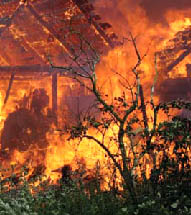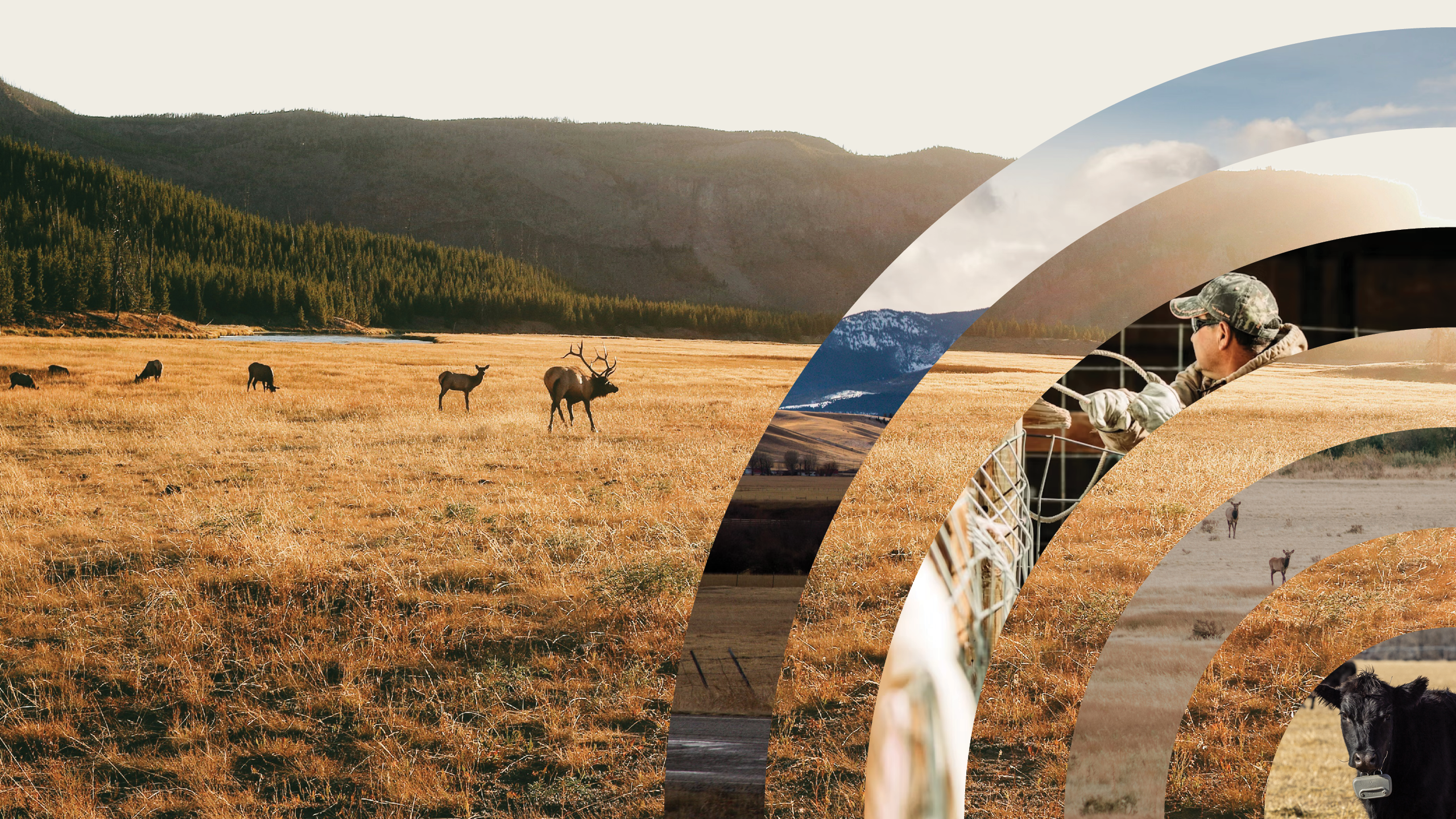
Last summer, as flames from the Castle Rock fire threatened multi-million dollar mansions in Sun Valley and nearby Ketchum, insurer American International Group, Inc. (AIG) took notice. Members of AIG’s elite Private Client Group pay an average yearly premium $10,000, and in return they are protected with special emergency services. Tom Futral, AIG’s fire protection contractor, rolled into town as authorities were issuing evacuation orders and Forest Service firefighters were working round the clock.
Armed with a spray gun and a truckload of fire retardant, Futral coated AIG’s premium customers’ homes and the surrounding landscaping. One neighbor, not an AIG client, asked if he might be able to hire Futral’s services. But Futral’s docket was full—if you were not already on the list, you were out of luck.
The key is to begin long before the sparks fly. For example, developers in areas bordering forested lands can use fire-resistant landscaping and building materials – particularly for roofing.
The results were striking. When flames did approach the treated homes, a clear line was visible on shrubs—half black, half green—where the fire had been halted by the retardant. This service is a nobrainer for AIG; the potential payout if just one of these homes was lost to fire dwarfs the cost of Futral’s services.
Although this last-ditch protection was available only to the very wealthy, anyone can take low-cost preventative measures that significantly reduce the risk of home ignition in the event of a wildfire. This prevention is often much more effective than Forest Service fire suppression efforts.
The key is to begin long before the sparks fly. For example, developers in areas bordering forested lands can use fire-resistant landscaping and building materials—particularly for roofing. Ongoing maintenance by homeowners is also important; trimming branches back from structures and keeping lawns and gutters free from debris like pine needles or leaves. A complete and detailed list of these simple, inexpensive preventative measures is available at www.firewise.com.
Research shows that fire-resistant landscaping within a 120-foot radius, combined with non-flammable roofing material, can significantly increase the ability of a structure to withstand a wildfire. Fuels reduction treatments outside of the 120-foot radius were found to be ineffective and inefficient for protecting structures from wildfire. So, the burden for home protection—from a preventative standpoint—largely falls on the private homeowner.
Fire and the Feds
Federal agencies bear much of the responsibility for wildfire control. Some claim that the Forest Service is to blame for creating hazardous fire conditions—and therefore is responsible for protecting its neighbors from the consequences of its mistakes. Indeed, in some national forests, decades of fire suppression by the Forest Service has resulted in hazardous accumulations of flammable fuels.
“We’ve watched what you’ve done and now we can protect your home”- firefighter’s comment to homeowners who reduced the risk of their house burning by thinning forest on their property, which borders public lands.
Historically, fires sparked by lightning or by Native Americans burned through some forests every 15 to 35 years, clearing out brush and favoring the growth of older, thick-barked, fire-resistant trees. One Forest Service study estimates that, due to past federal fire suppression policy, 30 percent of national forests have been “significantly” altered from historical conditions, and another 39 percent have been “moderately” altered.
That leaves 31 percent of national forests that have not been altered from their historical conditions, for several reasons. Some forests burned during the last century, despite Forest Service suppression efforts. Other areas have been treated by the Forest Service in recent years for hazardous fuels reduction, either through mechanical removal of fuel or prescribed burning. And some forests are not historically prone to frequent fire and so have not been disturbed by decades of Forest Service fire suppression.
Sixty-nine percent of the national forests—116 million acres—have been altered to some extent by fire suppression. The Forest Service has proposed fuels reduction treatments in these areas to restore the ecological role of fire and to protect their neighbors from the risks of catastrophic wildfire. But fuels reduction on most Forest Service land will not be effective in protecting neighboring structures from wildfire—since most Forest Service land is more than 120 feet from structures. Except in the few cases where national forest boundaries fall within that 120-foot radius, the most valuable preventative efforts will be on private land and are the responsibility of the homeowner.
Private Fire Protection
Examples abound where fire tears through a wildland-urban interface neighborhood, and some houses are decimated while others remain unscathed. Last fall in southern California, the Witch Fire swept through five San Diego subdivisions that were built, landscaped, and maintained to “firewise” standards, without a single home igniting. Nearby, 1,125 homes burned to the ground.
As more homes (particularly more expensive ones) encroach on forested lands, the insurance industry is taking more notice. AIG’s premium wildfire protection services is one example. State Farm Insurance Company takes a different approach, offering lower premiums to homeowners in six western states, who take preventative steps—clearing debris, moving woodpiles away from structures, trimming back branches—to protect their homes from wildfire.
Local jurisdictions are also adopting regulations that require homeowners to reduce the risk of home ignition. Regulations exist at the state, county, or city level in California, Oregon, Colorado, Florida, Idaho, Montana, New Mexico, Utah, and Washington. Some local fire departments and zoning boards have enacted fire standards for new developments in high-risk areas. But these regulatory and insurance mechanisms are still relatively small-scale, compared to the scope of the wildland-urban interface fire threat.
Vigilantes Fight Back
The concept of homeowner responsibility is gaining recognition, and with this trend, some rural residents are exploring additional possibilities. Although most of the focus thus far has been the preventive measures that homeowners can take, there may also be a way for homeowners to participate in fire suppression.
A model exists in Australia, where a policy of “evacuate early, or stay and defend” encourages those who are able to remain at home to protect their own property from fires. This policy recognizes three key points: carefully built and maintained homes can protect residents from the radiant heat of wildfire, residents can protect structures by extinguishing small spot fires ignited by stray embers long after the fires (and firefighters) have passed through, and hasty last-minute evacuations create the most dangerous and deadly wildfire situations. Children, the elderly, and the disabled are encouraged to evacuate long before the flaming front approaches. Those who remain behind keep a vigilant watch for embers, which can travel miles from the flaming front and enter homes through vents or eaves,smoldering for hours.
Armed with a spray gun and a truckload of fire retardant, Futral coated AIG’s premium customers’ homes and the surrounding landscaping.
This “shelter-in-place” concept contrasts sharply with the U.S. approach, which favors complete evacuation of large areas under threat from wildfire. Although the intent of this policy is to keep people out of harm’s way, the results can be devastating. Some residents linger too long and are not aware that they are safer at home than attempting to evacuate as the flames encroach. Seventy-five percent of fatalities in California’s 2003 Cedar and Paradise fires occurred during evacuations. Complete evacuation can also result in the loss of more structures. Even the most elite firefighters cannot track every ember or keep an eye on every building. With watchful residents on site, more homes are likely to survive blazes.
Of course, no approach to wildfire is without risk. With shelter-in-place, there is the risk that some people will still attempt dangerous last-minute evacuations, or that residents will try to stay and defend homes that are not constructed or maintained to firewise standards. U.S. agencies prefer to avoid these risks, and instead favor evacuation—keeping people away from the flames, even if some houses may be lost to stray embers.
Primed for Change
Although the United States might not be ready for shelter-in-place during wildfires, the country is certainly primed for a change in its approach to wildfire. The Forest Service has long recognized the importance of fire to North American ecosystems, but most fires on national forests are still suppressed—in 2005, more than 99 percent— largely because of the threats to private property in the wildland-urban interface.
The risk escalates as communities continue to push their boundaries into forested areas. Between 1970 and 2000, the developed portion of the wildland-urban interface grew in size by 52 percent, and this trend is expected to continue, according to a 2007 study from Colorado State University.
With more development comes a higher bill for fire suppression. One USDA audit reports that between 50 and 95 percent of Forest Service fire suppression budgets, which have averaged more than $1 billion per year since 2000, is spent protecting private homes in the wildlandurban interface.
As more developments encroach on forested lands, federal agencies cannot continue to take responsibility for their neighbors, passing the bill on to the taxpayers at large. It would behoove residents of the wildland-urban interface to recognize the threats that exist in their locations and to take preventative steps to protect themselves in the event of wildfire.


